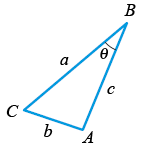
Mark D. answered • 08/04/20
Expert Calculus Tutor, Electrical Engineer, Artificial Intelligence
[ALL STEPS EXPLAINED]
We use the Law of Cosines, which says:
a2 = b2 + c2 - 2bc Cos(A)
b2 = a2 + c2 - 2ac Cos(B)
c2 = a2 + b2 - 2ab Cos(C)
STEP 1 - Solve for angle B:
b2 - a2 + c2 = -2ac Cos(B)
(b2 - a2 + c2 ) / -2ac = Cos(B)
arccos((b2 - a2 + c2 ) / -2ac) = arccos (Cos(B))
arccos((b2 - a2 + c2 ) / -2ac) = B
B = arccos((b2 - a2 - c2 ) / -2ac)
STEP 2 - Calculate the values:
(Typically, 2 decimal places is ok)
a2 = 61.012 = 3722.22
b2 = 36.672 = 1344.69
c2 = 42.952 = 1843.41
2ac = 2*61.01*42.95 = 5240.76
STEP 3 - Plug in values
B = arccos((1344.69 - 3722.22 - 1843.41 ) / -5240.76)
B = arccos(-4220.94 / -5240.76)
B = arccos(0.8054)
ANSWER:
B = 0.69 radians
B = 36.35 degrees
____________________________________________________________________________________
*Note: Using more significant digits, the answer becomes B=36.32662, (or 36.33 degrees)
(RELATED CONCEPTS)
Note 1: Convert degrees to radians: 36.33 degrees * (3.14 radians / 180 degrees) = 0.63 radians
Note 2: Change calculator mode to RAD or DEG to get the correct value for arccos and cos-1
Note 3: arccos(x) = cos-1(x) -- the same
Note 4: cos-1(x) is different than cos(x)-1 = 1/cos(x) = sec(x), do not get them mixed up







Erick G.
Theta would correspond to angle b, in other words, 36.33 degrees08/04/20